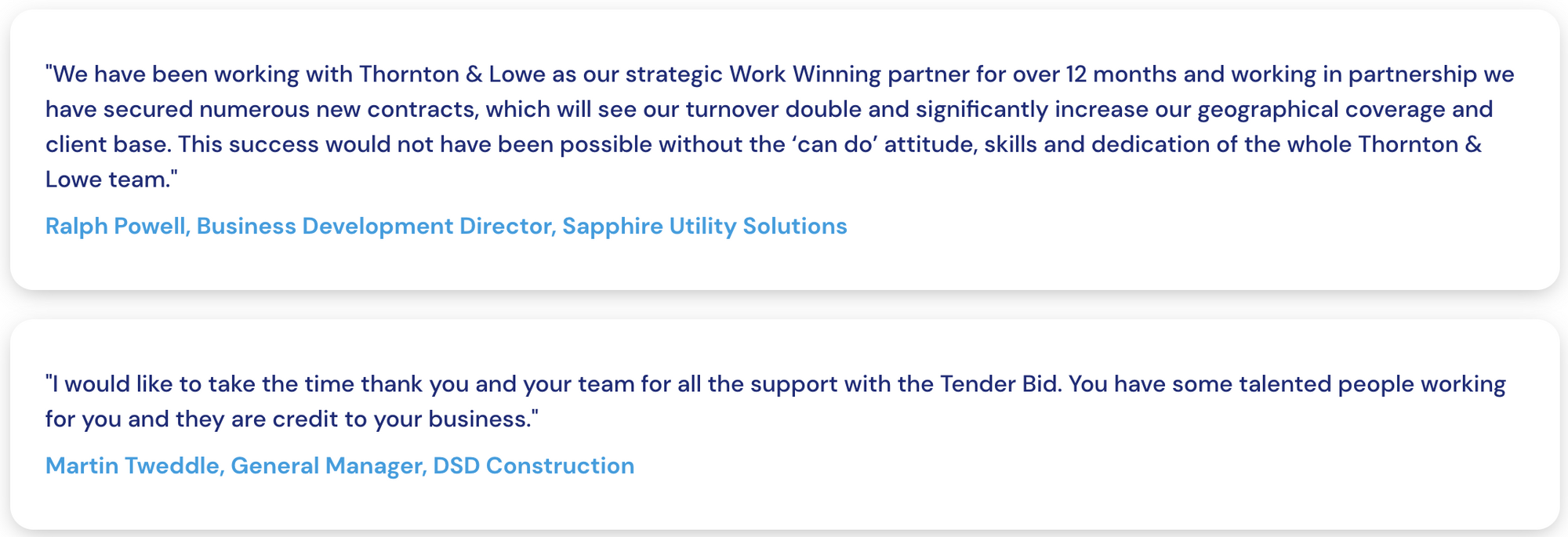An Expression of Interest (EOI) is an important part of the procurement process. This early step lets buyers know that you're interested before the full tender process starts. In this guide, we cover how to write a stand-out EOI that gets your business noticed. Need help? Thornton & Lowe's expert team can support you through every stage.
Get EOI support todayWhat is an EOI or Expressions of Interest?
Expressions of Interest play a key role in the early stages of tendering. They help organisations find potential suppliers and give businesses a chance to show their capabilities.
Definition and Purpose of EOI
An Expression of Interest (EOI) is a document that lets companies show they want to take part in a project or provide goods and services. It's a way for businesses to say "We're interested!" before the full tender process begins.
EOIs serve several purposes:
- They let buyers see who might bid on a project
- They help suppliers learn about new opportunities
- They save time by narrowing down the pool of potential bidders
When you submit an EOI, you're not making a full offer - You're just showing you have the skills and experience to do the job.
Role in the Tendering Process
EOIs come at the start of the tender process. They help both buyers and suppliers make good choices about where to focus their efforts.
For buyers, EOIs:
- Show how many companies might bid
- Help create a shortlist of qualified suppliers
- Give a sense of what the market can offer
For suppliers, EOIs:
- Let you learn about new projects early
- Give you a chance to stand out from competitors
- Help you decide if a project is right for your business
After the EOI stage, buyers might invite some companies to submit full bids. This next step often involves more detailed proposals.

A Strong EOI is a Crucial Step for Procurement Success
When an organisation needs goods or services, they often start by asking for EOIs.
An EOI helps buyers find qualified suppliers and narrow down their options before asking for full tenders. Often part of Preliminary Market Engagement (PME) where a buyer is completing market research and looking to discuss with potential suppliers their interest and options. It's less detailed than a full tender, and can be the click of a button with a government tender portal (Yes, I'm interested), so it's quicker and easier for both sides. You'll usually need to give basic info about your company and why you're a good fit for the job.
In some procurement exercises, the EOI is also a competition and route of shortlisting. If your EOI is successful, you might be invited to submit a full tender, ITT or business proposal. This could be called a Request for Tender (RFT) or Request for Proposal (RFP). These next steps ask for more details about how you'd do the work and how much it would cost.
In most public sector tenders an EOI is literally - clicking a button in a tender portal to show you are interested and therefore access the full tender pack and any clarification questions.

Private Sector EOI vs Public 'Portal Approach'
Public Sector EOI | Private Sector EOI |
|---|---|
|
|
|
|
|
|
|
|
|
|
It's important to note that while these are common differences, there is a trend of larger private sector tenders following a more formal portal-based procurement routes similar to the public sector.
EOI Submission Guidelines
When submitting an Expression of Interest (EOI) compliance is your first hurdle in ensuring success. Follow any guidelines provided and seek clarity to ensure your EOI is easy to push through to the next tendering stage.
Formatting and Documentation
Your EOI must follow the specific format outlined in the tender instructions. Use clear headings and subheadings to organise your content. Include all required documents, such as:
- Company profile
- Financial statements
- Relevant experience and qualifications
- References from past clients
This is information which should be prepared, in a bid library, ready to be tailored. It's part of your tender readiness preparation. Make sure to number pages and sections for easy navigation. Use a consistent font and size throughout. Check that all attachments are clearly labelled and referenced in the main document. But really, at this stage there shouldn't be too many!
Submission Deadline
Meeting the submission deadline is crucial. Late EOIs are often rejected without review. To ensure timely submission:
- Note the exact date and time of the deadline
- Submit your EOI well before the cut-off time
- Allow extra time for potential technical issues
- Confirm receipt of your submission if possible
If submitting electronically, check file size limits and accepted formats.
Professional Presentation
A professional presentation sets your EOI apart. Focus on:
- Clear, concise writing free of jargon
- Proper grammar and spelling
- High-quality images and graphics (if allowed)
- Consistent branding throughout
Use bullet points and tables to present information clearly. Proofread carefully to catch any errors. If printing, use high-quality paper and binding. A polished presentation shows attention to detail and professionalism, increasing your chances of moving forward in the tender process.

Preparation of an EOI
Writing and preparing an effective Expression of Interest (EOI) can require planning and attention to detail. A well-prepared EOI demonstrates your company's strengths and aligns with the client's needs.
As they say, "you never get a second chance to make a good first impression", and for many businesses this is what an expression of interest is. It's that first chance, the put the 'best foot forward' and set yourself apart from the pesky competitors.
Key Elements of an EOI
For a more detailed EOI you should include:
- A cover letter
- An executive summary
- and main body.
The cover letter introduces your company and expresses your interest in the project. Keep it brief and engaging. The executive summary highlights your key qualifications and unique selling points. Aim for a concise one-page overview. Within our Business Proposals guide we provide more details and examples. In the main body, detail your company background, relevant experience, and approach to the project. Use clear headings and bullet points to improve readability.
Include supporting documents like case studies, team CVs, and financial information in appendices.
It should look great, so consider bid design opportunities and reflect the brands of both organisations.
Understanding Client Requirements
Carefully read the EOI request to grasp the client's needs and expectations. Identify the key selection criteria and project goals.
Research the client organisation and industry to tailor your response. Show how your expertise aligns with their specific requirements.
Address each criterion directly in your EOI. Use examples to demonstrate how you've met similar requirements in past projects.
Highlight any unique solutions or innovations you can offer that set you apart from competitors.
Evidence of Capability and Experience
Provide concrete evidence of your company's ability to deliver. Include details of similar projects you've completed successfully.
Use metrics and data to quantify your achievements. For example, "Completed £5 million project on time and 10% under budget."
Showcase your team's expertise by including brief bios of key personnel. Highlight relevant qualifications and experience.
Include testimonials or references from satisfied clients. These add credibility to your claims and demonstrate your track record.
Consider creating a simple table or chart to summarise your experience across different project types or sectors.
Tendering Success with T&L
Submitting a strong Expression of Interest (EOI) is often the first step in winning public and private sector contracts. A professional EOI demonstrates your company’s capability and suitability for a project, increasing your chances of being invited to tender.
At Thornton & Lowe, we provide expert support to help you respond to EOIs and the wider tendering process, including:
- Bid & Tender Writing – Crafting clear, persuasive EOIs and full tender submissions tailored to each opportunity.
- Procurement Guidance – Advising on procurement requirements, helping you understand what buyers are looking for.
- Consultancy Services – Assisting with bid strategy, competitor analysis, and submission planning.
- Training & Development – Equipping your team with the skills to create compelling EOIs and tenders.
Whether you need help structuring an EOI or managing the full tendering process, our specialists ensure your submissions stand out.

Looking for a bid management partner?
Contact usAssessment Criteria of an Expression of Interest
Assessment criteria are key factors in evaluating expressions of interest. They help determine which submissions move forward in the tendering process. Clear criteria ensure fair and consistent evaluation.
Evaluating Fitness to Tender
When assessing EOIs, evaluators look at several key areas. These include:
- Financial stability
- Technical capability
- Relevant experience
- Resources and capacity
- Quality assurance systems
Your EOI should address each of these points clearly. Provide concrete examples and data to back up your claims. Use bullet points or tables to present information concisely.
Evaluators may also consider:
- Your understanding of project requirements
- Innovative approaches or solutions
- Health and safety record
- Environmental policies
Make sure your EOI is well-organised and easy to read. This shows attention to detail and professionalism.
Need bid support? Or a quote?
Contact us todayFollow-Up After EOI Submission
After submitting your EOI, stay proactive and responsive. Keep communication lines open with the procuring entity and be prepared to address any queries promptly and thoroughly.
Don't hesitate to reach out politely if you haven't heard back within the expected timeframe. A brief email or phone call can show your continued interest and commitment.
Keep records of all communications and feedback. Note down dates, names, and key points discussed. This information may be useful if you progress to later stages of the tender process.
Handling Queries
Be ready to answer questions about your EOI submission. The procuring entity might ask for clarifications or additional details.
Respond promptly and thoroughly to all queries. Double-check your answers for accuracy before sending them. If you need more time to gather information, let them know and provide a realistic timeframe for your response.
Ensure a secondary email or contact is provided, or if you are away from the office that someone can still access the feedback and respond. One way that businesses manage this is by using a tender@ email for example, which goes to a group for continuity. This can work well but ensure it does not lose any personal elements as relationship is still key!

EOI: Frequently Asked Questions
Expressions of Interest are a key part of many tendering processes, but we understand that many businesses new to bidding for tenders may have a few questions...
How do I respond to an Expression of Interest?
Ensure you understand expectations. If you have a relationship with the client or if you can speak to them, ask exactly what they expect from you.
Within a public or Government tender, it may simply be registering on a portal, clicking 'expression of interest' and this automatically then gives you access to the tender documents.
For others it may in itself be a competitive process. It is therefore important you ensure your EOI provides a good and relevant overview of your business and why you are well placed to supply/ support the business, including qualifications, capacity and accreditations. Focus on your unique strengths which will be important to the buyer. Highlight past successes and relevant experience. Use clear, concise language to show why you're the best fit.
Tailor your EOI to the specific project. Research the client's needs and address them directly. Include any certifications or special qualifications that set you apart.
In what ways do Requests for Proposals (RFPs) differ from Expressions of Interest (EOIs)?
RFPs are more detailed than EOIs. They ask for specific project plans and often require pricing information. EOIs are shorter and focus on your qualifications and interest.
RFPs are usually part of the final selection process. EOIs are often used to create a shortlist of potential bidders. RFPs require more time and resources to complete than EOIs.
How does an Expression of Interest in procurement procedures typically function?
In procurement, an EOI helps buyers gauge market interest. It lets suppliers show their capability to deliver a product or service. Buyers use EOIs to create a list of qualified suppliers.
EOIs can save time in the procurement process. They allow buyers to focus on the most suitable suppliers. For suppliers, EOIs are a chance to get a foot in the door.
What distinguishes an Expression of Interest from a Request for Information (RFI) in tendering?
EOIs focus on your company's qualifications and interest in a project. RFIs are used by buyers to gather information about potential solutions or suppliers.
EOIs are a step towards bidding on a project. Meanwhile, RFIs are often used earlier in the process to help shape project requirements. EOIs can require more detail about your company than RFIs.





